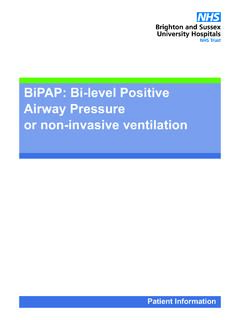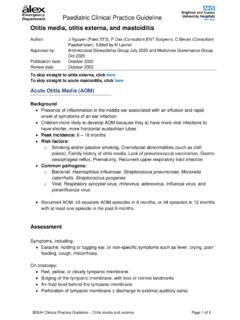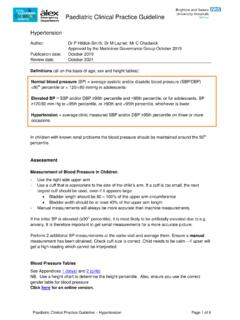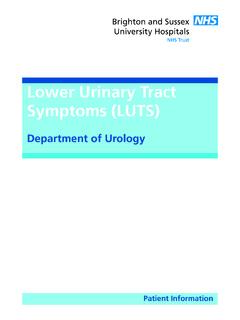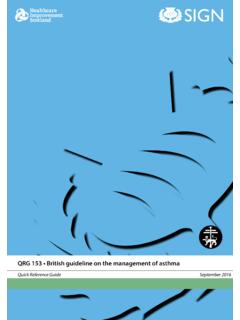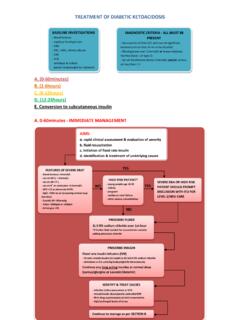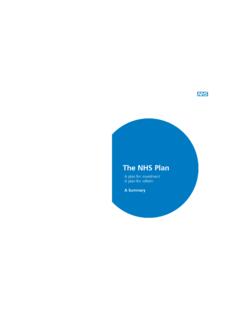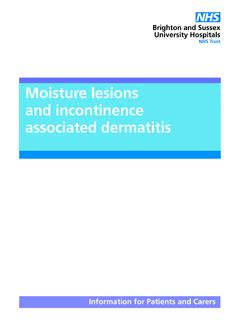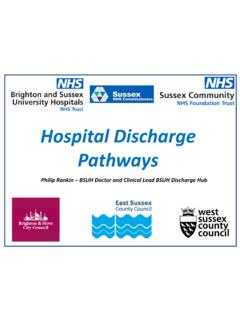Transcription of Paediatric Clinical Practice Guideline Eczema / Atopic ...
1 Paediatric Clinical Practice Guideline The Alex Clinical Practice Guideline Eczema Page 1 of 6 Eczema / Atopic Dermatitis Author: Dr M Lazner, Ms L Benfield, Dr S George, Mr C Chadwick Approved by: Medicines Governance Group December 2021 and Antimicrobial Stewardship Group May 2022 Publication date: May 2022. Version 3 Review date: May 2024 Background Eczema is a chronic, relapsing, inflammatory, itchy skin condition. Treatment of an individual patient should be modified according to need and circumstances, and may involve a multi-disciplinary approach. Diagnosis and Assessment 1) Diagnosis If it doesn t itch it is unlikely to be Eczema (BAD, 2010) Must have an itchy skin condition plus 3 or more of the following: History or visible flexural dermatitis with skin crease involvement (or cheeks and/or extensor dermatitis if 18 months Personal (or 1st degree FH if < 4 years) of Atopic illness Personal history of dry skin in last 12 months Onset under the age of 2yrs in children > 4 years NB.
2 In Asian or black children, Eczema can affect the extensor surfaces rather than the flexures, and discoid (circular) or follicular patterns may be more common. Consider a diagnosis of food allergy if: Previous reaction to food with immediate symptoms Failure of control with optimum management, particularly if associated with gut problems or faltering growth See cow s milk protein allergy Guideline on Microguide for further management Ask about: time of onset, pattern and severity response to previous and current treatments possible triggers irritants, skin infections, contact allergens, food allergens, inhalant allergens impact on patients and carers growth and development household pets dietary history and manipulation personal and family history of atopy Consider a diagnosis of inhalant allergy if: seasonal flares of Atopic Eczema , Eczema associated with asthma or allergic rhinitis aged 3 years with Atopic Eczema on the face, particularly around the eyes.
3 Consider a diagnosis of allergic contact dermatitis if: exacerbation of previously controlled Atopic Eczema reactions to topical treatments Paediatric Clinical Practice Guideline The Alex Clinical Practice Guideline Eczema Page 2 of 6 2) Assess severity Areas of differing severity can coexist at the same time. Determine whether Mild, Moderate or Severe, and direct treatment as described. Inform child and carers of your assessment findings MILD: Areas of dry skin + infrequent itch (+/- reddening) MODERATE: Areas of dry skin + frequent itch + reddening (+/- areas of excoriation / thickened skin) SEVERE: Large areas of dry skin + incessant itch + reddening (+/- areas of excoriation / thickened skin / cracking / oozing). CONSIDER SUPERADDED INFECTION (see 2a) Always consider the impact Eczema has on a child s and carer s quality of life. This won t necessarily correlate with severity of Eczema . Effect on school life (?Missed days) Concerns about appearance Poor sleep due to itching Low mood Can be quantified using the Children s Dermatology Life Quality index or the Patient-Oriented Eczema Measure (POEM).
4 Can also use visual analogue scales (0-10) re: patient and carers assessment of severity, itch and sleep loss (over previous 72 hours). 2a) Consider superadded infection see 4a) for management of infected Eczema . Images: ( ) NB. Eczema is often colonised with bacteria but may not be infected. Likewise not all flared or crusted / weeping Eczema is infected Bacterial infection with streptococcus or staphylococcus is suggested by: weeping, pustules, crusting Surrounding cellulitis with erythema of otherwise normal skin Failing to respond to treatment or rapidly worsening Eczema with fever and malaise Eczema Herpeticum (Herpes simplex infection), requires RAPID diagnosis and PROMPT treatment. This should be considered: If infected Eczema fails to respond to antibiotics and topical steroids Areas of rapidly worsening, painful Eczema (over hours to days) Clusters of vesicles and/or punched-out erosions / depressed ulcers, usually 1- 3 mm. Bacterial (staph aureus) infection Eczema herpeticum infection Paediatric Clinical Practice Guideline The Alex Clinical Practice Guideline Eczema Page 3 of 6 Management 3) Every day treatments AVOID potential triggers: Scratching - advise rubbing in circular motions with fingers, keep fingernails short Extremes in temperature, humidity or stress role unclear in triggers Irritating clothing (inc.
5 Wools, and synthetic fibres) Soaps and detergents (replace with emollients) Baby wipes and bubble baths Focus on keeping skin hydrated with use of EMOLLIENTS: Should be always be used, even when the Eczema is clear Apply to the whole body in larger amounts and more often than other treatments every 4 hrs or at least 3 - 4 times daily Use a cream base for wet / weeping skin, and an ointment base for dry Eczema Prescribe in large quantities (250 500g weekly). Leave several minutes between application of emollients and other skin products. It does not matter which one goes on first. Smooth on skin rather than rubbing in, along the lie of the hair in downward strokes to prevent follicular clogging (not in a circular motion) Use emollients and/or emollient wash products instead of soaps, wash products, and shampoos. See the Brighton joint primary care formulary for prescribing options. Advise an alternative emollient if a particular one is causing irritation or not acceptable.
6 4) Management of flares Topical steroids provide symptomatic relief and are safe in the short term (aim for up to 14 days in acute flares). Start treatment as soon as signs and symptoms appear and continue for 48hrs after resolution Apply steroids to areas of active Eczema (within past 48 hours) including broken skin Consider secondary infection and in particular if no resolution with topical steroids within 7 14 days Consider prescribing anti-histamines for severe itch or sleep disturbance o Non-sedating for up to a month for severe itch or urticaria o Sedating for 7 14 days if sleep disturbance significant in > 6 months old Cool compresses can be useful for immediate relief of itch o Apply to itchy areas for 5 10 minutes, apply emollient post compress o You can also use a wet dressing for the face, and are best applied whilst awake and when feeding Paediatric Clinical Practice Guideline The Alex Clinical Practice Guideline Eczema Page 4 of 6 MILD Eczema management Generous emollient use (as above)
7 Mild potency topical steroids to affected areas MODERATE Eczema management Generous emollient use (as above) Moderate potency topical steroids once a day to affected areas except on face and neck. Use moderate potency on vulnerable areas axillae and groin for max 7 to 14 days Continue mild topical steroids on face and neck SEVERE Eczema management Generous emollient use (as above) For children > 12 months old, use potent corticosteroids to affected areas for as short a time as possible, and maximum 14 days Use moderate potency steroids on vulnerable areas for max 7 to 14 days Can increase to moderate potency steroids on face and neck for max 3 to 5 days Consider secondary infection, and swab any oozing areas (see 4a) Wet-wraps (consider starting ASAP) may require admission for QDS application by trained staff. See useful resources section for further advice. Sedating anti-histamines may be indicated if sleep is significantly disturbed. SEEK DERMATOLOGY OPINION / GUIDANCE if o child does not respond to treatment after 1 week o Child is < 12 months and requires potent steroids o You are considering topical tacrolimus or pimecrolimus Use a step wise approach to management: Recommended topical steroids Potency Drug Mild Hydrocortisone 1% Moderate Clobetasone Butyrate (Eumovate) Betamethasone valerate (Betnovate RD) Potent Betamethasone valerate (Betnovate) Mometasone fumorate ( elocon ) Use cream base for wet / weeping skin or ointment for dry Eczema .
8 One fingertip unit (FTU) = steroid Paediatric Clinical Practice Guideline The Alex Clinical Practice Guideline Eczema Page 5 of 6 4a) Management of superadded infection NB. topical steroids can be applied to broken skin / infected areas. Don t use occlusive dressing or dry bandages to treat infection If evidence of bacterial infection (see 2a): Don t routinely swab unless frequent recurrence of infection, infection worsening or no improvement with treatment. If swab taken, ensure results are chased up and treatment altered accordingly If the child is well, does not have underlying conditions such as immunosuppression, and the infection is not widespread or severe, consider not treating with antibiotics (the evidence suggests limited benefit with antibiotics + topical corticosteroids vs steroids alone, as well as risk of antimicrobial resistance with repeated courses of antibiotics) Explain that most people with Eczema are colonised with Staph aureus and may not necessarily be infected.
9 However, just treating the Eczema with topical steroids alone will help decrease the Staph aureus on the skin as well. If decision made to treat with antibiotics (see BNFc for doses): If evidence of herpes simplex infection (see 2a), always treat with aciclovir: If localised, treat with oral aciclovir. If generalised Eczema herpeticum is suspected, start IV aciclovir immediately. Refer to Dermatology same day in all cases of suspected Eczema herpeticum. Refer for Opthalmology opinion if any periorbital involvement. Consider concurrent bacterial involvement, and potential for antibiotics on top of aciclovir. Swab lesions and send for virology. 5) Referral pathways For urgent issues, contact Dermatology Registrar via switchboard in working hours. Referral letter to Dermatology Consultants, via secretaries Dermatology secretaries: ext 62204 (RACH) or at BGH (01273) 665019 Dermatology CNS (BGH) ext 5074 or 5035 Nurse led Eczema education programme via Consider Dermatology referral for: If treatment of secondary infection has failed, refer to Dermatology for urgent assessment.
10 Uncertain diagnosis or if contact allergic dermatitis suspected persistent Atopic Eczema or facial, eyelid or hand Atopic Eczema ; Manage obvious cellulitis as per cellulitis guidelines Localised areas: Consider treatment with topical antibiotics 2% Fucidic acid topical TDS for 5 7 days Don t give topical treatment if widespread areas of infection, multiple previous topical courses, patient preference. Widespread areas or child is unwell: give oral antibiotics (Flucloxacillin for 5 7 days, Clarithromycin if penicillin allergy). Use above choices if IV antibiotics are indicated unwell child, not able to tolerate oral medication Paediatric Clinical Practice Guideline The Alex Clinical Practice Guideline Eczema Page 6 of 6 or if Eczema on the face has not responded to appropriate treatment management has not controlled the Eczema satisfactorily according to child, parent or carer 1 to 2 weeks of flares per month or adverse reaction to multiple emollients Eczema is giving rise to significant social or psychological problems for the child, parent or carer sleep disturbance, poor school attendance.
